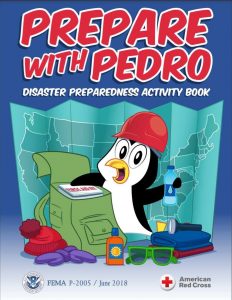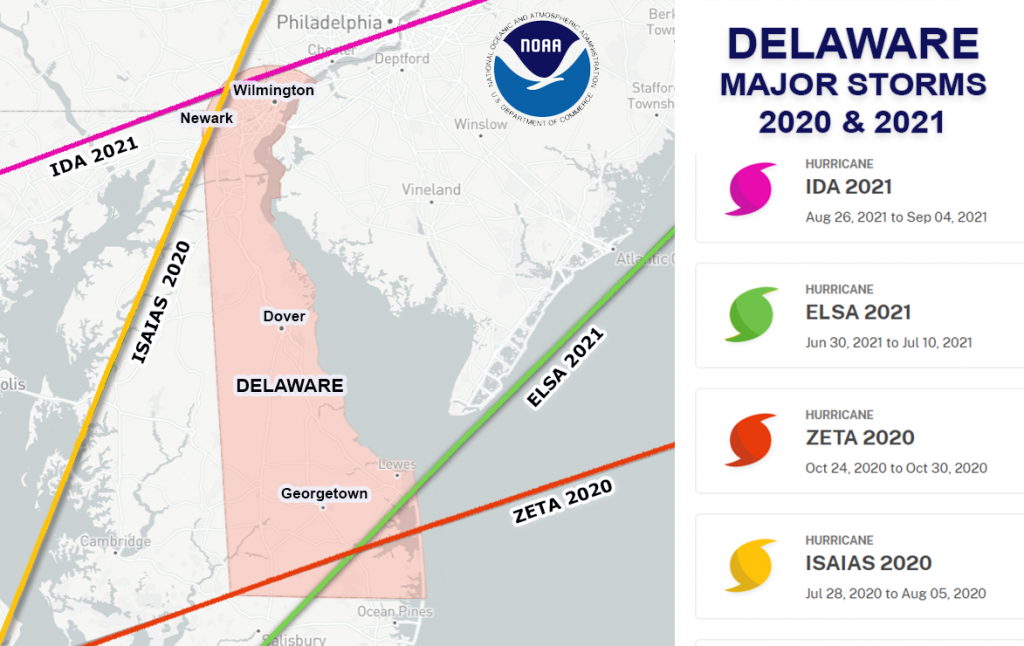Make a plan. Make a kit. Stay informed. – PrepareDE.org
SMYRNA, Del. – “Get Prepared, Delaware!”
That’s the key message from the Delaware Emergency Management Agency (DEMA) as it offers tips and resources to help residents and visitors to get ready in case a hurricane or tropical storm impacts the First State.
The Atlantic hurricane season is June 1 to November 30. This year, the National Oceanic and Atmospheric Administration (NOAA) forecast is predicting an above-average season: 14 to 21 named storms, 6 to 10 hurricanes, and 3 to 6 major hurricanes. So far, the Atlantic Basin has had only three named storms: Alex, Bonnie, and Colin. However the potential risk is still very real.
Delaware does not need to have a direct hit from a hurricane to experience the most disastrous effects of a major weather event: storm surge and severe coastal flooding, high winds, inland flooding, tornadoes, large waves, and rip currents. Delaware’s average elevation is only 60 feet above sea level, but most of the state south of the C & D Canal is lower. The state’s unique location on the Delmarva Peninsula – surrounded by water on three sides – makes it vulnerable to storm surge on top of high tides.
Recent history shows even the remnants of a hurricane or tropical storm can pack a powerful punch. In August 2020, Tropical Storm Isaias spawned a record-breaking 29.2-mile tornado with maximum winds up to 105 mph that wreaked a devastating path of destruction from Dover to Middletown. One woman in Milford was killed by a falling tree after the storm. And in September 2021, historic amounts of rainfall from Tropical Depression Ida caused record flooding in the Brandywine Creek in and around the City of Wilmington, causing millions in catastrophic property damage that resulted in a federal disaster declaration for New Castle County.
Experts agree the best time to prepare is now, before a storm, and there are many county, state, and federal resources to help residents get ready.
Here are the key recommendations from DEMA as it urges residents to prepare for a potential hurricane:
 Make a Plan.
Make a Plan.
- Know your flood risk. Are you in a flood zone? Find out at de.gov/floodrisk. If you are, you might be asked to evacuate in advance of a severe weather event. Know what the evacuation plan will be by checking the DelDOT State Evacuation Routes.
- Prepare your home. Secure loose items in your yard and on your house. Have a plan for how to stay cool if the power goes out. Keep non-perishable food, water, and extra medications to sustain each member of your family plus pets for up to 7 days. Check your insurance and purchase flood coverage if possible. It can take up to 30 days to go into effect. Learn more about the National Flood Insurance Program at www.fema.gov/flood-insurance
- Create a plan for how to communicate with your household if a disaster occurs. Talking through and planning for different scenarios is important. For example, members of your household may not be together when disaster strikes, so it is important to plan in advance how you will contact one another, how you will get back together, and what you will do in different situations. FEMA provides numerous types of plans for different family members that you can download, fill out, and print for your family: for parents, for kids, for pets, for commuters, and for evacuations.
- Take seniors and special needs into account. Plan for special populations with access and functional needs such as the elderly, and those with medical needs or language barriers. Don’t forget to plan for your pets too!
- Preparedness Buddy: Learn about the DHSS Office of Preparedness and the “Preparedness Buddy” program. The University of Delaware also has resources to help plan for an emergency at: www.allreadyde.org/
- Pets and Animals: The DHSS Office of Animal Welfare and Delaware Animal Response Program has resources for animals and emergencies.
- “Practice makes prepared!” Once you have a plan, go over it and make sure everyone knows what to do. Children can also be a part of the plan and help practice it with the family! Check out the brochure “Prepare with Pedro” at ready.gov.
Make a Kit.
- Go to preparede.org/make-a-kit to learn what items you should include.
Emergency kit for your home and for your vehicle:
-
- Water – one gallon per person per day
- Food – non-perishable, three-day supply, and can opener if kit contains canned food
- First aid kit (see below) and medications
- Personal hygiene items – toilet paper, feminine supplies, hand sanitizer, moist towelettes, and soap
- COVID-19 personal protective items – masks, disinfecting wipes, travel-sized soap for washing hands, hand sanitizer
- Flashlight
- Battery-powered or hand crank radio
- Extra batteries for radio, flashlight, etc. – check expiration dates and replace as necessary
- Cash – ATM and credit card machines may be out of service in event of power outages
- Mess kits, paper cups, plates, paper towels, and plastic utensils
- Cell phone power bank or car charger
- Copy of important documents in waterproof portable container or sealed Ziploc bags
- Special-needs items for children – medications, toys, infant formula, and diapers
- Special-needs items for seniors or people with disabilities – medications, glasses, hearing aids and batteries, dentures etc.
- Matches in a waterproof container
First-aid kit:
-
- Cleansing agent/soap and antibiotic towelettes
- Disposable gloves (consider nitrile to avoid possible latex allergy problems)
- Masks (at least 2 per person just in case one is lost)
- Adhesive bandages in a variety of sizes
- Sterile dressings and gauze
- Ointments – antibiotic, burn, anti-itch
- Eye wash solution
- Scissors
- Over-the-counter medicines – pain relievers, allergy relievers, anti-diarrheal medication, laxatives
- Prescription medications and supplies – insulin, heart medicine, glucose monitoring equipment, blood pressure monitors
- Tourniquet (to learn about how to Stop the Bleed, including how to use a tourniquet, visit StopTheBleed.org)
Pet supplies kit:
-
- Additional water and food – recommended 1 gallon per pet per day
- Collar with ID tag, leash or harness, and record of microchip
- Medications and first-aid kit
- Important documents in a plastic zip-top bag, including: medical and vaccination records, license and microchip numbers; etc.
- Current photos of you with your pet in waterproof portable container or sealed Ziploc bags
- Transport crate or carrier
- Bedding and toys
- Blankets or sleeping bags and pet bedding
- Vet records (including license, vaccination, and microchip)
- Pet containment (crate or carrier) and restraint (collar with ID tag, leash, and harness)
Stay Informed.
- Evacuation Planning. Determine whether to shelter-in-place or evacuate. If Emergency Management or Public Safety tell you to evacuate, do so immediately. Guidance is at this link.
- Identify local radio stations, television stations, and cell phone emergency alerts and warnings.
- County and city-specific information is available here.
- Consider limited evacuations routes off the peninsula, especially if a hurricane is imminent.
- Check out the DelDOT State Evacuation Routes (powered by ArcGIS)
- Remember:
- COVID-19 restrictions both at home and at your potential evacuation destination. What are the mask and social distancing requirements, and do you have you COVID-19 safety kit items in your Emergency Kit?
- Plan for your pets, too. Always take them with you – NEVER leave them behind, even if you think you will only be gone for a few hours.
- Take Proof of Residence (ex: bill with your name and address) with you for when you are returning to your home, as public safety officers will restrict reentry to residents only.
- Stay informed by monitoring the DEMA social media pages, local officials, and local weather.
- Download the FEMA Mobile App (with custom local alerts) or the DelDOT Mobile App.
- The Delaware Emergency Notification System (DENS) is the primary system for public warning and emergency protective action information in Delaware. The system allows local 911 centers or emergency managers to send messages to the specific street, neighborhood, or larger areas affected by the event. Register for free at de.gov/dens.For a wealth of preparedness tips: go to PrepareDE.org.
Resources
- DelDOT State Evacuation Routes (powered by ArcGIS)
- DelDOT Mobile Phone App – FREE
- FEMA Mobile Phone App – FREE
- FEMA General Hurricane Information
- FEMA General Evacuation Information
- Delaware Emergency Management Agency
- NOAA National Hurricane Center Hurricane Tracker
- NOAA National Weather Service Hurricane Preparedness
- HurricaneStrong.org
- City of Wilmington Office of Emergency Management
- New Castle County Office of Emergency Management
- Kent County Emergency Management
- Sussex County Emergency Operations Center
Social Media: Follow Delaware Emergency Management Agency on Facebook and Twitter and Instagram
The Federal Emergency Management Administration (FEMA) also has resources to help you prepare: ready.gov/hurricanes
Contact:
John Petersen, Delaware Emergency Management Agency
302-659-2211 (office) 302-233-8180 (cell)
Email: john.petersen@delaware.gov
####
